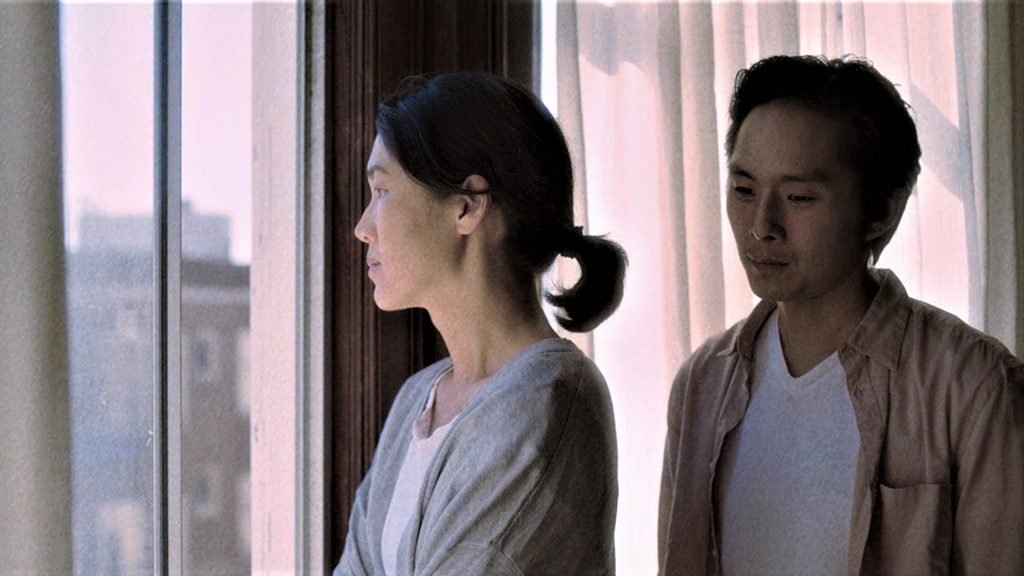By Andrew Hamlin
Northwest Asian Weekly

A figure in running gear emerges into the film frame, panting hard as he jogs up a steep hill. One of his heavy exhales turns into a scream. The scream paralyzes the young man. He freezes on screen, hangs limp like a rag doll. Then slowly, meticulously, back to running. And occasionally more screaming, all the way home.
The young man, who turns out to be Justin Chong from the “Twilight” saga, comes home to his dying mother. He’s meticulous. He’s restrained. He focuses relentlessly on caring for her. But memories sometimes haunt him. Memories of when his mother was well.
That’s the basic premise for “Coming Home Again,” Wayne Wang’s stark, artful exploration of life and death in a Korean American family. According to the director, Chong’s isolation against the cityscape was all part of the plan.
“Empty spaces mean a lot,” commented Wang on the film, which opens on Oct. 23 in theaters and through the Virtual Cinema watch-at-home program (outsiderpictures.us). The director, who co-wrote “Coming Home Again” with Chang-rae Lee, invoked the teachings of master Japanese director Yasujro Ozu.
Ozu, explained Wang, spoke a great deal about “how the environment has a soul, and the emotions of the characters are always in the environment.”
In the case of this new film, the environment was one San Francisco apartment.
With a few exceptions, notably the jogging sequence, “Almost everything happens in that apartment. It was lived in by 30-some years, by the [film] producer’s grandma.
“The minute I walked into that apartment, I felt there was a spirit there, that was quite interesting. I couldn’t figure out what that spirit was, but I wanted to capture it. There were a lot of pictures left on the refrigerators, and the walls, that were pictures of three generations, who have actually gone through there.”
Filming wasn’t as simple as bringing in cameras, though. The film producer’s family is Chinese, and the story—co-written by Wang with Chang-rae Lee from an autobiographical essay Lee published in The New Yorker—concerns a Korean family.
To nail down Korean details, Wang took on an unusual ally: Corey Lee, a master chef at Benu, one of the very few Michelin three-star restaurants in the San Francisco Bay Area.
According to Wang, Chef Lee “took one look at the kitchen and he said, this kitchen is all wrong, this kitchen is so Chinese. The sauces are wrong, the spices are wrong, the containers are wrong, the utensils are wrong. Then he opened the refrigerator and everything in there was Chinese. It was very gratifying to know that Corey saw the differences and could help me authenticate everything.”
The director also praised Richard Wong, director of photography on “Coming Home Again,” for his framing of each shot, those crucial empty spaces surrounding the actors in each shot.
“And I also like him because he doesn’t light a lot. These days, with these digital cameras, you don’t need to light a lot. Things could go really fast. One of the other tricks with non-actors, if you do a lot of lighting, they wait around, they get anxious.”
Using non-actors—folks not professionally trained as actors—is risky onscreen, but Wang’s used to the approach, as far back as his breakout film “Chan Is Missing,” from 1982.
“I’ve always used real people,” Wang explained. “They tend to get a little scared. So if you help them relax, and they can be themselves, that works out very well. But the trick is that you have to pick them very carefully. You have to instinctively know that they know themselves, that they’re confident in what they’re doing. And then I very simply set up what they need to do or say. And they can be on their own.”
Wayne conceded that going to an old-fashioned movie theater is risky these days. Many folks won’t want to go that route. But he’s hoping that some will.
“The screen is larger [at a theater]. You can let your eyes wander in the film, [through] a lot of the static shots, a lot of shots in the environment. You want to immerse yourself.”
Andrew can be reached at info@nwasianweekly.com.



